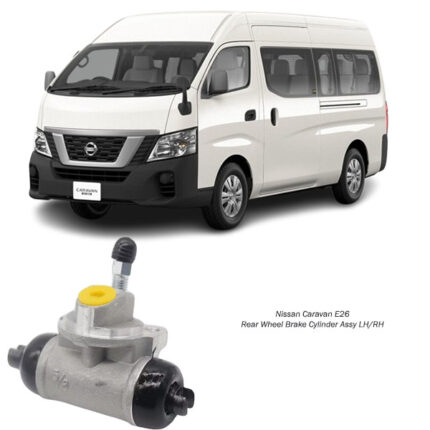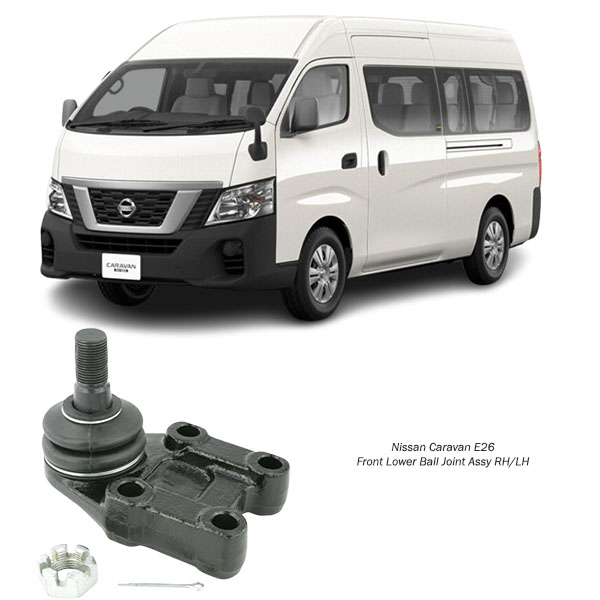-17%
Get Nissan Caravan E26 Front Lower Ball Joint Assy RH/LH 40160-VW000 in Kenya
The Front Lower Ball Joint Assembly, whether on the Right-Hand (RH) or Left-Hand (LH) side, is one of the most critical components in the suspension and steering system. Despite its compact size, it plays a huge role in ensuring your vehicle stays stable, responsive, and safe—especially when turning, braking, or driving over uneven terrain.
Without strong, healthy ball joints, the control and comfort of a vehicle can quickly deteriorate, leading to dangerous handling, abnormal tire wear, and eventually suspension failure. In this guide, we’ll take a deep dive into what this part does, how it works, common failure symptoms, and why it’s so important.
🔍 What Is the Front Lower Ball Joint Assy?
A ball joint is a flexible pivot point that connects the control arm (part of the suspension) to the steering knuckle (which holds the wheel hub and bearing). Specifically, the front lower ball joint is located at the lower end of the steering knuckle, connecting it to the lower control arm.
The “Assy” (assembly) version refers to the complete unit, which typically includes:
-
The ball stud (a steel ball with a threaded shaft)
-
The socket or housing (often filled with grease and sealed with a rubber boot)
-
A mounting plate or bracket for installation
-
A dust boot to prevent dirt and moisture from entering
This joint enables the suspension to move vertically while allowing the wheel to rotate left and right—essentially giving the wheel full range of motion while maintaining a strong, secure connection.
🤖 How It Works
Imagine the ball joint as the human shoulder joint. It allows for a wide range of movement in multiple directions, while also bearing substantial loads. That’s exactly what a front lower ball joint does for a vehicle’s suspension.
Here’s what it handles:
-
Vertical movement as the suspension travels up and down over bumps and dips
-
Rotational movement as the wheels turn left or right via the steering system
-
Support of vehicle weight, especially in setups where the lower joint carries more load than the upper joint
This dual role—support and movement—makes the lower ball joint essential to both the handling and ride comfort of a vehicle.
📌 RH vs. LH – Why Both Sides Matter
RH (Right-Hand) and LH (Left-Hand) ball joints are typically mirror images of each other. They may share similar function and design, but are made to fit specifically on their respective sides of the vehicle.
Installing the correct side ensures:
-
Proper alignment
-
Safe suspension geometry
-
Correct steering response
-
Even tire wear
It’s usually recommended to replace both RH and LH ball joints at the same time to maintain balance and symmetry in the front suspension.
🛑 Signs of a Worn or Failing Ball Joint
Because ball joints wear gradually, symptoms may creep up slowly until failure becomes dangerous. Here are the most common signs to watch for:
1. 🔊 Clunking Noises
One of the most noticeable symptoms. A worn ball joint allows excess movement, creating a clunk or knock—especially when turning or going over bumps.
2. 🛞 Uneven or Rapid Tire Wear
A failing ball joint can alter wheel alignment, causing the inside or outside edge of the tire to wear much faster than the rest.
3. 🧭 Steering Wandering or Loose Feel
If the front end feels “floaty” or difficult to keep straight, it may be due to a loose or worn ball joint no longer maintaining stable steering geometry.
4. 💥 Vibration in the Front End
Loose joints can allow wheels to wobble slightly, especially at higher speeds, leading to steering wheel vibrations.
5. 🔧 Excessive Play
During inspection, excessive up/down or side-to-side play in the joint indicates wear. Mechanics often check this by lifting the vehicle and moving the wheel manually.
🚨 Dangers of Ignoring Ball Joint Issues
Driving with a bad front lower ball joint is not just uncomfortable—it’s dangerous. Ignoring this component can result in:
-
Complete joint failure, which can cause the wheel to collapse inward or outward
-
Loss of control, especially during turns or at high speeds
-
Broken suspension components, like damaged control arms or steering knuckles
-
Severely damaged tires, leading to blowouts or skidding
Because of the vital role it plays in safety, a failing ball joint should be addressed immediately.
🔁 When Should It Be Replaced?
There’s no universal timeline for ball joint replacement—it depends heavily on driving conditions, load, terrain, and maintenance habits. That said, ball joints often last between 80,000 to 150,000 kilometers.
Replace your front lower ball joint when:
-
Any of the warning signs appear
-
During front suspension or steering system overhauls
-
The dust boot is torn, allowing contamination to cause internal wear
-
A mechanic confirms excess play or noise during inspection
It’s good practice to replace them in pairs (RH and LH) to maintain even handling and suspension response.
🧰 How Replacement Is Done
Replacing a front lower ball joint requires skill, proper tools, and attention to detail. Here’s a simplified process:
-
Raise and support the vehicle on jack stands.
-
Remove the front wheel on the affected side.
-
Disconnect the steering knuckle from the control arm by removing the ball joint nut.
-
Use a ball joint separator tool or press to release the joint from its seat.
-
Remove the old joint (sometimes the control arm needs to come out depending on design).
-
Install the new joint assembly, ensuring it’s torqued to spec.
-
Reassemble everything, double-checking alignment and safety.
-
Perform a wheel alignment after replacement to restore proper geometry.
🛡️ Maintenance and Prevention Tips
Although modern ball joints are often sealed and “maintenance-free,” the following steps help extend their lifespan:
✅ Regular Inspections
Have the suspension checked during routine service intervals, especially if driving on rough roads frequently.
✅ Monitor Dust Boots
A torn or damaged boot allows dirt and water in, accelerating joint wear. Replacing the boot early can save the joint.
✅ Listen for Noises
Unusual sounds, especially when turning or going over bumps, shouldn’t be ignored.
✅ Avoid Overloading
Excessive weight adds strain to all suspension components, especially the ball joints.
📊 The Role in Vehicle Performance
The front lower ball joint is central to many critical vehicle dynamics:
-
Precise steering input
-
Consistent suspension geometry
-
Proper ride height and comfort
-
Tire alignment and longevity
-
Safe braking and handling under pressure
When it functions properly, it creates a seamless connection between the road and the driver’s control. When it fails, the entire front-end system suffers.
🧠 Final Thoughts
The Front Lower Ball Joint Assembly RH/LH may not look impressive at first glance, but it’s a vital link in the suspension chain. It bridges movement and support, enabling smooth, safe, and predictable handling. Keeping these joints in top shape ensures that the front wheels respond exactly as they should—whether you’re navigating a tight turn or cruising straight down the highway.
Being aware of symptoms and acting early can prevent more expensive repairs and ensure your driving experience remains safe and reliable. A well-maintained ball joint equals a well-connected driver.
Follow us on Facebook for more parts.




Reviews
Clear filtersThere are no reviews yet.